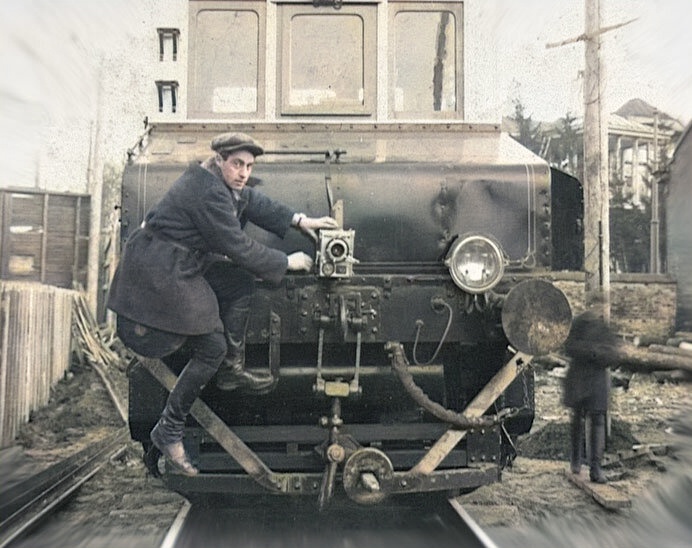 |
| Mikhail Kaufman acts as the cameraman to get a shot from a moving train, from Wikipedia. Remember, these movie cameras were hand cranked, not automatic. |
If you have become involved in the new technology of Instagram or Hipstamatic, you know about the variety of images that bombard you in your feed every day. I am fascinated by that immense variety. Taken together they give us an interesting view of our modern world.
Now, imagine taking that variety of images, combining them with cinema techniques, such as film montage, split screen, double-exposure, stop-action, and you have a pretty good idea of the 68 minutes of the 1929 Russian silent film by director Dziga Vertov called The Man with the Movie Camera.
Recently, Sight and Sound magazine did a survey and Vertov's film ranked No. 8 in 846 critics greatest films.
Vertov states at the beginning that the film is intended as "AN EXPERIMENTATION IN THE CINEMATIC COMMUNICATION OF REAL EVENTS, WITHOUT INTERTITLES, WITHOUT A SCENARIO, WITHOUT THE HELP OF THEATRE (actors, sets, etc.)"
The cutting and pacing of the film (done by Vertov's wife, Elizabeta Svilova) often reminds me of an interview George Lucas did regarding Star Wars where he said that they experimented to see how fast they could cut from image to image and have the eye still register it. The film does the the same. With the fascination of speed and movement, there are parts that become a thrill ride of visual stimuli.
The film begins by taking us into a movie theatre where we see the projector and the audience, reminding us that this is cinema.
The film is primarily urban based. Vertov (and his cameraman, Mikhail Kaufman) show us a full visual dictionary of Russian life, filled with store windows, mannikins, trolleys, posters, people working, pistons, mailmen, crowds, cars, factories. The camera is constant throughout. Never are we to assume he is not there. In one early sequence we see a horse-drawn carriage and its occupants, then we see the cameraman, then we see shots of the cameraman with the carriage and its occupants. As we get into the pacing of the horse running, we suddenly stop and see still photographs and eventually photographs of the film strips themselves and Elizabeta cutting them into sequences.
The editor has a wonderful sense of juxtaposition of themes and variations, mixed with irony. A couple register a wedding, another registers a divorce, a woman gives birth, a funeral carriage bears the open casket of a young man surrounded by flowers.
We see fingernails being worked on, women's hair being cut, makeup and eyebrows being applied, and move on to see sewing and counting money; newspaper printing cuts to a woman who creates cigarette packages and eventually hands packing cigarettes into the same packages.
We see the ever-present cameraman on top of trucks, trains, cranes over dams, deep in coal mines and factory iron vats.
We move from people learning to swim, to relaxing at the beach, to a newspaper layout and a whole montage on sports--among others, jumping hurdles, horse racing, diving, basketball, soccer, motorcycle racing, often in slow motion.
In a beer garden there is a trick shot of the cameraman in a beer glass, people drinking, bottles of beer and wine. These lead to shot of a woman at a shooting arcade, shooting at a metal woman with a swastika on her head (perhaps the only image for me that truly locks the viewer into the time period).
Near the end, there are more and more pictures of the cinema where we started with the cameraman seen in various shots. Often the cutting here is from images of action to static, almost still pictures of people reacting.
As much a part of the film as anything is the musical soundtrack played by The Alley Orchestra, using a full range of instruments, along with bottles, spoon, washboards, pie pans, bells, all supporting the moods of the various montages. [Note, the musical score in the YouTube version of the film is not the one I heard, which was supposedly based on the original. Like Metropolis, you can find various versions, each making the experience slightly different.]
The film is indeed "pure cinema." It reminds me of what Anton Chekhov states regarding his view of a naturalistic theatre:
After all, in real life, people don't spend every moment in shooting one another, hanging themselves, or making declarations of love. They do not spend all their time saying clever things. They are more occupied with eating, drinking, flirting, and saying stupidities. these are the things which ought to be shown on the stage. A play should be written in which people arrive, depart, have dinner, talk about the weather, and play cards. Life must be exactly as it is and people as they are. Let everything on the stage be just as complicated, and at the same time just as simple, as in life. People eat their dinner, just eat their dinner, and all the time their happiness is taking form, or their lives are being destroyed.
Vertov has shown us that world which has disappeared.
The Man with the Movie Camera (1929) ***** (iTunes or YouTube)

No comments:
Post a Comment